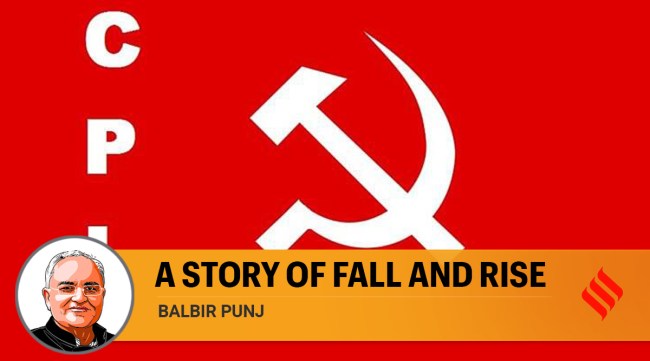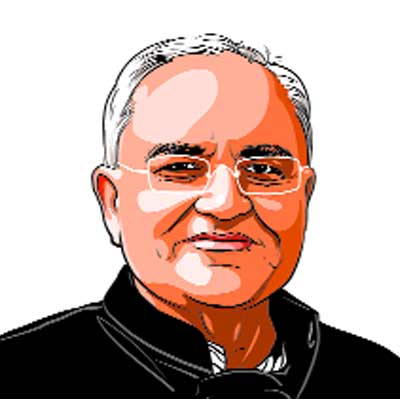Opinion Balbir Punj writes on derecognition of CPI as a national party: A story of fall and rise
CPI declines while RSS and India grow. The two are connected
 While the CPI’s footprint is getting obliterated from India’s political scene, the country is busy writing a success story. The party’s inescapable fall and India’s rise are surely intertwined developments. (Wikimedia Commons)
While the CPI’s footprint is getting obliterated from India’s political scene, the country is busy writing a success story. The party’s inescapable fall and India’s rise are surely intertwined developments. (Wikimedia Commons)
One recent political development that went unnoticed was the derecognition of the Communist Party of India (CPI) as a national party by the Election Commission. For close to a century, the CPI has been an intrinsic part of the undulating saga of India’s social and political life. While the CPI’s footprint is getting obliterated from India’s political scene, the country is busy writing a success story. The party’s inescapable fall and India’s rise are surely intertwined developments.
The RSS and the Indian chapter of the Communist International (the CPI’s forerunner) were both born in 1925. Until its dissolution in May 1943, each communist party, including the Communist Party of India, was by its constitution, “a section of the Communist International”, headquartered in and controlled by Moscow. The joke was that when it rained in Moscow, comrades opened their umbrellas in India!
The days chosen for the birth of the two organisations by their respective founding fathers probably said a lot about their orientation. The RSS was born on September 27, on Vijay Dashami and the Communist Party, three months later, on December 26, when the world was busy celebrating Christmas and was absorbed in new year festivities.
While the CPI is near extinction, the influence of its ideological break-away faction, the Communist Party of India (Marxist) or CPI(M), is confined to Kerala, and elite institutions like Jawaharlal Nehru University (JNU) in Delhi, with no traction in the rest of the country. The Maoists/Naxals, wedded to the gun, too are remnants of the Left movement. Restricted to a few tribal pockets, they operate overground and underground, depending on the exigencies of the situation, in a few urban areas.
In contrast, the BJP, inspired by the RSS, rules the Centre and has a pan–India presence. The RSS, through its affiliates, has an impact on almost all aspects of Indian cultural, social, political and economic life.
With the collapse of the Soviet Union in 1991, the inadequacies of communism were exposed to the world. In India too, the communists increasingly lost their relevance. In the years to follow, India managed to break out of what was derisively called the “Hindu rate of growth” and has now established itself as an emerging economic powerhouse.
Why is the CPI dying, while the RSS and India rise? Are these developments connected? Yes, they are. The RSS aspires to rebuild the country, drawing heavily from timeless Indian values, such as pluralism and harmony, and recognising and respecting diversity. The CPI, on the other hand, believed that India’s reconstruction was possible after the complete pulverisation of its traditional values, beliefs and social structures.
In the article ‘The British Rule in India’ in The New York Daily Tribune, (June 25, 1853) Karl Marx said: “We must not forget that these little communities were contaminated by distinctions of caste and by slavery, that they subjugated man to external circumstances instead of elevating man to be the sovereign of circumstances, that they transformed a self-developing social state into never changing natural destiny, and thus brought about a brutalising worship of nature, exhibiting its degradation in the fact that man, the sovereign of nature, fell down on his knees in adoration of Hanuman, the monkey, and Sabbala, the cow.”
The British and the communists had a shared perspective of India. On the destruction of Indian (Hindu-Buddhist) culture, they were on the same page. The British wanted to colonise the Indian mind and transform it into an extension of the British psyche. The communists, on the other hand, were striving to turn India into a Soviet satellite. Without a doubt, both the communists and the British aimed to destroy the idea of India in Indians.
Did the Indian communists fight the British? Yes, they did, but only to the extent that it suited the Soviet Union.
The fact that Indian communists were a mere extension of the Soviet Union’s foreign policy and interests, was proved beyond doubt during the Second World War. On August 23, 1939, the Soviet Union entered into a pact with Hitler. Arraigned against them were Great Britain and its allies. The CPI was upset with Congress because it did not impede British war efforts. After Hitler and Stalin fell out, and the Soviet Union teamed up with allies, the communists made a complete U-turn. They were once again upset with Congress, now because it had launched the Quit India movement, and was disrupting the British war efforts.
When India attained freedom in 1947, they refused to accept that India had become independent. Nehru was decried and India was proclaimed to be ripe for armed insurrection. The armed offensive for the final capture of power began in 1949, which Sardar Patel put down with a heavy hand.
When China invaded India in 1962, the CPI maintained that a socialist nation (China) couldn’t be an aggressor. In 1964 , the party split, with the breakaway faction christening itself as CPI (M). The split in the CPI was merely an extension of the Sino-Soviet split.
The declaration of Emergency in 1975 by a desperate Indira Gandhi was justified by the CPI. The party said that Emergency has been declared to foil the international conspiracy to destabilise India. In return for this betrayal of Indian democracy, the communists managed to smuggle themselves into the system, with the help of a complicit and acquiescing regime.
For obvious reasons, there was always a disconnect between the communists and the rest of India. But is communism dead in India now? The CPI, as an organisation, may have reached its nadir, but communism as an ideology has permeated deep, particularly in mass media and academia, and still influences the narrative, within and without the country. Since the idea of India was never central to the CPI’s existence, no tears were shed over its demise.
The writer is a former Member of Parliament and a columnist






